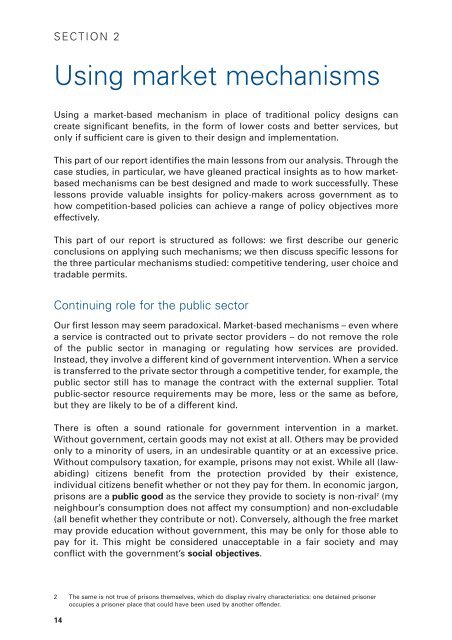Public Policy: Using Market-Based Approaches - Department for ...
Public Policy: Using Market-Based Approaches - Department for ...
Public Policy: Using Market-Based Approaches - Department for ...
Create successful ePaper yourself
Turn your PDF publications into a flip-book with our unique Google optimized e-Paper software.
SECTION 2<br />
<strong>Using</strong> market mechanisms<br />
<strong>Using</strong> a market-based mechanism in place of traditional policy designs can<br />
create significant benefits, in the <strong>for</strong>m of lower costs and better services, but<br />
only if sufficient care is given to their design and implementation.<br />
This part of our report identifies the main lessons from our analysis. Through the<br />
case studies, in particular, we have gleaned practical insights as to how marketbased<br />
mechanisms can be best designed and made to work successfully. These<br />
lessons provide valuable insights <strong>for</strong> policy-makers across government as to<br />
how competition-based policies can achieve a range of policy objectives more<br />
effectively.<br />
This part of our report is structured as follows: we first describe our generic<br />
conclusions on applying such mechanisms; we then discuss specific lessons <strong>for</strong><br />
the three particular mechanisms studied: competitive tendering, user choice and<br />
tradable permits.<br />
Continuing role <strong>for</strong> the public sector<br />
Our first lesson may seem paradoxical. <strong>Market</strong>-based mechanisms – even where<br />
a service is contracted out to private sector providers – do not remove the role<br />
of the public sector in managing or regulating how services are provided.<br />
Instead, they involve a different kind of government intervention. When a service<br />
is transferred to the private sector through a competitive tender, <strong>for</strong> example, the<br />
public sector still has to manage the contract with the external supplier. Total<br />
public-sector resource requirements may be more, less or the same as be<strong>for</strong>e,<br />
but they are likely to be of a different kind.<br />
There is often a sound rationale <strong>for</strong> government intervention in a market.<br />
Without government, certain goods may not exist at all. Others may be provided<br />
only to a minority of users, in an undesirable quantity or at an excessive price.<br />
Without compulsory taxation, <strong>for</strong> example, prisons may not exist. While all (lawabiding)<br />
citizens benefit from the protection provided by their existence,<br />
individual citizens benefit whether or not they pay <strong>for</strong> them. In economic jargon,<br />
prisons are a public good as the service they provide to society is non-rival 2 (my<br />
neighbour’s consumption does not affect my consumption) and non-excludable<br />
(all benefit whether they contribute or not). Conversely, although the free market<br />
may provide education without government, this may be only <strong>for</strong> those able to<br />
pay <strong>for</strong> it. This might be considered unacceptable in a fair society and may<br />
conflict with the government’s social objectives.<br />
2 The same is not true of prisons themselves, which do display rivalry characteristics: one detained prisoner<br />
occupies a prisoner place that could have been used by another offender.<br />
14
















